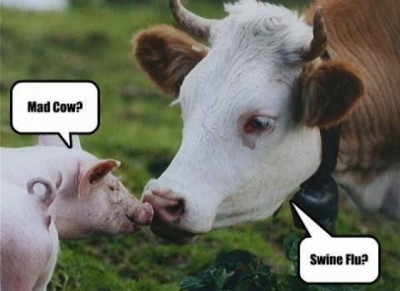The Department of Agriculture announced that it had identified a case of mad cow disease, the first in six years, in a dairy cow in central California.
The cow “was never presented for human consumption, so it at no time presented a risk to the food supply or human health,” John Clifford, chief veterinary officer at the department, said in a statement.
Dr. Clifford noted that milk did not transmit bovine spongiform encephalopathy, the scientific name for mad cow disease. He expressed confidence in the health of the nation’s cattle and the safety of beef during a press briefing in Washington.
 The animal had been picked up from the farm and taken to a rendering plant, which noticed some of the signs of B.S.E., such as unsteadiness and aggression, and notified U.S.D.A. inspectors, Dr. Clifford said in a brief interview.
The animal had been picked up from the farm and taken to a rendering plant, which noticed some of the signs of B.S.E., such as unsteadiness and aggression, and notified U.S.D.A. inspectors, Dr. Clifford said in a brief interview.
The body will remain at the rendering facility and will be disposed of once the agency completes its investigation, probably by incineration or some other method that ensures the destruction of its tissues.
It was the fourth reported case of mad cow disease, a degenerative disease that affects the brains and spinal cords of cattle, in the United States. Humans can contract the disease by eating meat from an infected cow.
Only one case of mad cow disease in the United States was of the type derived from feed. That case set off a panic in 2003 when a Canadian-born cow in Washington state tested positive.
Exports of American beef plummeted as countries instituted bans, and livestock producers and meatpacking companies lost billions of dollars. Asian nations in particular remain wary of American beef, and news Tuesday that another infected cow had been identified sent cattle futures for June delivery to their lowest level in 11 months.
The U.S.D.A. tested more than 795,000 animals in the 18 months after that cow was identified and found only two more cases. Neither was a type of B.S.E. associated with infected feed.
In 2006, the department said the identification of only two additional infected animals suggested it was using a bazooka to fight a mouse. It cut its surveillance program by 90 percent, despite criticism from consumer groups.
Those same critics on Tuesday complained again about the department’s surveillance program. “We really don’t know if this is an isolated unusual event or whether there are more cases in U.S. beef,” Dr. Michael Hansen, senior scientist at Consumers Union, the advocacy arm of Consumer Reports. “Our monitoring program is just too small.”
The two other animals with mad cow disease as well as the one identified on Tuesday all had a form called atypical B.S.E. “We do not believe this was passed to the animal through infected feed materials,” Dr. Clifford said.
Switzerland reported a case of atypical B.S.E. in March, as have many other countries. “Our best prevailing wisdom about this is that there may be a spontaneous form of this cow dementia,” said Dr. Will Hueston, a professor of public health at the University of Minnesota. “This new case appears to be that sporadic type of the disease, a sole cow that happens to get it at random and without any predictive characteristics.”
NY Times
Leave a Reply
You must be logged in to post a comment.